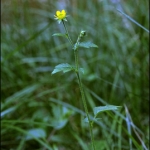| Common Name: |
Wood Avens |
| Other Names: |
Avens, Herb Bennet |
| Botanical Name: |
Geum urbanum |
| Genus: |
Geum |
| Family: |
Rosaceae |
| Cultivation: |
Rich, moist soil in shade. |
| Propagation: |
By seed sown in autumn or spring. Self-seeds freely. |
| Harvest: |
Plants are cut as flowering begins and dried for infusions and liquid extracts. Roots are lifted in spring and used fresh or dried for decoctions and liquid extracts. |
| Native Region: |
Europe, W Asia, Mediterranean Regions. |
| Height: |
20-60cm (8-24in) |
| Width: |
20-60cm (8-24in) |
| Hardiness: |
Z5-9 |
| Parts Used: |
Whole plants, roots. |
| Properties: |
An astringent, antiseptic herb that reduces inflammation, checks bleeding and discharges, lowers fever, and has a tonic effect on the digestive system. |
| Medicinal Uses: |
Internally for diarrhea, gastrointestinal infections, bowel disease, uterine hemorrhage, and intermittent fever. Externally for hemorrhoids, vaginal discharge, and inflammations of the mouth, gums and throat. |
| Bibliography: |
Encyclopedia of Herbs by Deni Brown Copyright © 1995, 2001 Dorling Kindersley Limited. pg 224.
|

